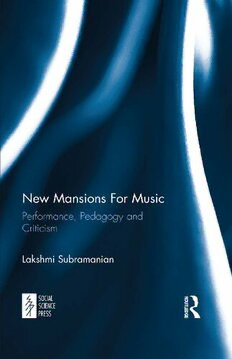
New Mansions for Music: Performance, Pedagogy and Criticism PDF
Preview New Mansions for Music: Performance, Pedagogy and Criticism
New Mansions for Music Taylor & Francis Taylor & Francis Group http:/ /taylora ndfra ncis.com New Mansions for Music Performance, Pedagogy and Criticism by Lakshmi Subramanian Firstpublished2018 byRoutledge 2ParkSquare,MiltonPark,Abingdon,OxonOX144RN andbyRoutledge 711ThirdAvenue,NewYork,NY10017 RoutledgeisanimprintoftheTaylor&FrancisGroup,an informabusiness ©2018LakshmiSubramanianandSocialSciencePress TherightofLakshmiSubramaniantobeidentifiedasauthor ofthisworkhasbeenassertedbyherinaccordancewith sections77and78oftheCopyright,DesignsandPatentsAct 1988. Allrightsreserved.Nopartofthisbookmaybereprintedor reproducedorutilisedinanyformorbyanyelectronic, mechanical,orothermeans,nowknownorhereafterinvented, includingphotocopyingandrecording,orinanyinformation storageorretrievalsystem,withoutpermissioninwritingfrom thepublishers. Trademarknotice:Productorcorporatenamesmaybe trademarksorregisteredtrademarks,andareusedonlyfor identificationandexplanationwithoutintenttoinfringe. PrinteditionnotforsaleinSouthAsia(India,SriLanka, Nepal,Bangladesh,Afghanistan,PakistanorBhutan). BritishLibraryCataloguinginPublicationData AcataloguerecordforthisbookisavailablefromtheBritish Library LibraryofCongressCataloginginPublicationData Acatalogrecordforthisbookhasbeenrequested ISBN:978-1-138-50318-2(hbk) ISBN:978-1-315-14528-0(ebk) TypesetinPlantin10/12 byElevenArts,Delhi110035 For Mushir, In appreciation Taylor & Francis Taylor & Francis Group http:/ /taylora ndfra ncis.com 5 Contents Preface and Acknowledgements ix Introduction 1 1. The Katcheri: A Living Laboratory or Enchanted Space? 32 2. Articulating an Aesthetic: The Emergence of the Music Critic in Modern South India 62 3. From the Gurukula to the University: Initiatives in Music Education 106 4. The Lighter Side of Entertainment 139 5. On the History of Music: A Bibliographical Essay 157 Glossary 164 Index 168 Taylor & Francis Taylor & Francis Group http:/ /taylora ndfra ncis.com 5 Preface and Acknowledgements THIS BOOK GREW OUT OF THREE SEMINAR PAPERS THAT I WROTE BETWEEN 2006–07. The idea of knitting them together as a single narrative was very largely my editor’s who convinced me that there was a book waiting to be written. I was initially hesitant having finished a book on music in south India just then, and apprehended the possibility of sounding repetitive. However, the hesitancy vanished when I actually set out to examine the subject of music and its troubled engagement with modernity, this time not as the biography of an institution but as snapshots of the principal actors who constituted the changing world of performance. Going back to my material I realized that the story had immense potential and that our entrapment in the world of textual representation meant that the focus was never on the practitioner but on the critic and the self- appointed connoisseur who chose to represent the artist not from the point of view of his dilemma but that of his own anxiety and self-reflexivity. To this day I regret that I failed to engage with my own music teacher who was, in so many ways, a remarkable individual and a realized musician. Growing up in modern India as a middle class girl, wrapped up in the excitement of youth and self-absorption, and only partially, even absentmindedly, interested in the music lessons, I learnt to love the form but failed to give it and its practitioner the attention they deserved. I do not claim that I have the means to recuperate the musician in history nor that I have done so in these pages. All that I have tried to do is to see how the emerging functions of criticism, pedagogy and performance positioned the musician in a changing public space and how the exercise in most
